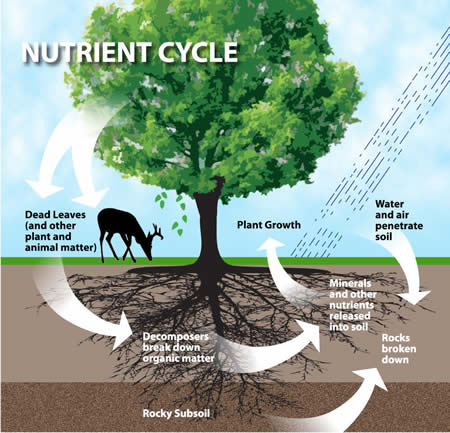NUTRIENT CYCLE
The nutrient cycle is how nutrients move from the physical environment into living organism and then back to the physical environment. It is an essential balance allowing life for plants and animals on this planet. The nutrient cycle can get out of balance and needs to be balanced and stable for organisms in the environment to flourish.
The nutrient cycle focuses primarily on two nutrients, carbon and nitrogen. These are essential to the overall soil fertility. There are other aspects of the nutrient cycle including sunlight, trace minerals, and rainfall.
In the carbon cycle plants use sunlight and a process called photosynthesis to remove carbon from carbon dioxide from the air and create plant mass that contains sugars, starch, protein, and other foods. We or animals eat the plants as food.
We, the animals, and the plants die ant the carbon matter is returned to the soil where it decomposes releasing the carbon atoms into the soil and back into the air as carbon dioxide.
The nitrogen cycle is similar except that the nitrogen is fixed into the ground by certain types of bacteria living in the roots of peas and beans.
There was a time before industrialization. It was a time before pumps, electricity, and the large scale capabilities for manufacture and implementation of big projects. People dug wells, lived in largely agrarian space groupings around the world. They would mostly inhabit land where basic needs could be secured. In such times and in various places, there was the awareness of the nutrient cycle and the need to enrich the land in order to survive.
What is manure in one context, is food in another. All manures break down into nutrients for plants in a continuous cycle known as the “nutrient cycle”. We are most concerned with the human nutrient cycle. The cycle works like this: a) we grow food, b) we eat food, c) we collect and process the organic residues (feces, urine, food scraps and agricultural materials) and we return the processed organic material back to the soil. This enriches the soil allowing more food to be grown. This cycle has repeated endlessly for thousands of years. This cycle maintains the fertility of the agricultural soils indefinitely instead of depleting them of nutrients.
This balance has been proven and continues to be proven in many parts of the world. It was first reported on by F.H.King in his book published in 1911 and titled Farmers of Forty Centuries. King traveled to Japan, Korea, and China and learned that manure was treated like a precious gem. Every scrap of animal waste, human waste, and plant residue was scrupulously collected and reapplied to the land. So precious was manure that Chinese farmers stored it in burglarproof containers.It was considered polite to visit your host’s bathroom before you left. King found yields five times greater than American agriculture even today (except where we do intensive gardening). Chinese agriculture was one big raised bed garden. It had to be this way in order to feed a very large population.
Our population is rising and we must improve the soils each year. Instead we are depleting our soils of nutrients by discarding organic materials as waste. According to the EPA, almost 80% of the net discarded solid waste in the U.S. is composed of organic material, and it is being buried in landfills. The humanure cycle is currently broken creating pollution, loss of soil, loss of soil fertility, and abuse of our water resources.
The nutrient cycle is how nature balances and creates growth on the Earth. We as part of the earth have an obligation to help keep the earth balanced and alive.


